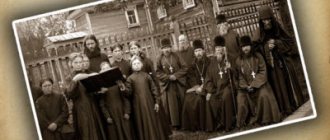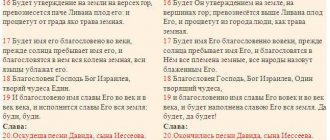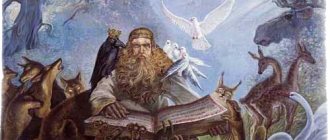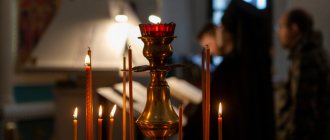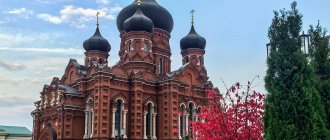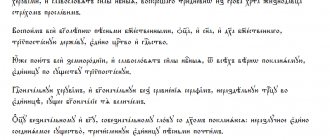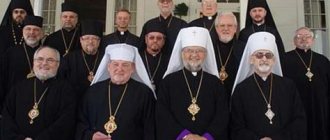This term has other meanings, see Official (meanings).
Official of the bishop's clergy
;
Official
[1] (Greek Άρχηιερατικόν) is the name adopted in the Russian Orthodox Church (ROC) for a liturgical book containing the rites of the Byzantine rite during the service of a bishop.
In addition to the texts contained in the Service Book, the Official
also contains texts and instructions related to the bishop's divine service: the rites of ordination (ordination in the degree of priest, reader, ordination to the rank of subdeacon, deacon, priest and bishop, consecration of antimensions and churches, cooking of the world, meeting of the bishop and his vestments.
Description of modern editions of the Official
The Modern Official is published in two books. In the first book
(one of the most widespread and commonly used publications of the Moscow Patriarchate, M., 1982, dedicated to the 25th anniversary of the episcopal consecration of Patriarch Pimen. Number of pages - 252.) contains the following:
- For Vespers (prayers typed in large print from the sequence of Vespers, set out in the missal),
- On lithium
- At Matins,
- Rite of the Divine Liturgy of St. John Chrysostom,
- Divine Liturgy of Basil the Great,
- Rite of the Divine Liturgy of the Presanctified Gifts,
- The rank of ordination to reader and singer (first to priest),
- The rite of ordination to subdeacon,
- The rank of ordination to the deaconate,
- The rank of elevation to archdeacon and protodeacon,
- The rite of consecration of a presbyter,
- The rite of elevation to protopresbyter,
- The rite of elevation to abbot,
- The rank of elevation to archimandrite,
- Vacations of the Master's holidays,
- Prayers of thanksgiving for Holy Communion (stated in the same sequence as in the service book. The prayer book is more complete),
- Months (on some days the memory of only one saint is indicated).
In the second book
(Publication of the Moscow Patriarchate, M., 1983, p. 175) contains the following:
- The rite of naming, confession and ordination of bishops,
- Consequence of consecration of antimensions,
- The rite of erection of the Honest and Life-Giving Cross,
- The rite of the great consecration of water on the feast of Epiphany,
- Prayers at the beginning of the Lent of the Holy Pentecost,
- The rite of blessing koliva,
- Following the Week of Orthodoxy (without anathematisms),
- Prayer for the consecration of willows (according to Russian tradition - the consecration of willows on the feast of the Entry of the Lord into Jerusalem),
- The rite of washing your feet on Maundy Thursday,
- Catechetical Sermon on the Holy and Great Sunday of Easter by St. John Chrysostom (From the Colored Triodion),
- Prayer for the blessing of artos,
- Prayer for the fragmentation of artos (on Saturday of Bright Week),
- Vespers prayers of Holy Pentecost on kneeling,
- Prayers for the blessing of grapes (for the Transfiguration),
- Prayers for the consecration of fruits (The same prayer in the service book and in the missal is inscribed Prayer for those who bear the first fruits of vegetables
, and in the menea two other prayers are given:
Prayer for the blessing of the grapes
and
Prayer over every fruit
), - The rite of consecration of the temple.
The given rites are performed either only by the bishop, or (unlike the Service Book) with the peculiarities of performing them by the bishop's rite.
This edition does not include some rites:
- The rite of consecration of the world,
- The rank of elevation to archbishop,
- The rank of elevation to metropolitan,
- The rite of enthronement (ascension to the throne of the patriarch),
- The rite of coronation of the august imperial persons,
- Anathematisms were removed from the Observance of the Week of Orthodoxy.
In 2009, a new edition of the Bishop's Official was published, which became the first book published by the Publishing Council with the blessing of Patriarch Kirill. In comparison with the 1982 edition, some changes have been made to the text of the new edition, reflecting the modern practice of bishops and the peculiarities of the Patriarchal ministry. In particular, the texts of the litanies used in the rites of ordinations of deacon and priest are placed both in the text of the corresponding rite, and (for the first time) on a special insert that can be temporarily given to the concelebrating archdeacon or priest. At the end of the volume the opening Psalm 103[3] is added. As in the 1982 edition, the texts of the bishop’s prayers and exclamations are typed in Church Slavonic font, and relatively large for ease of reading by the bishop; the rest of the prayers, as well as instructions and comments, are typed in a much smaller civilian font in Russian post-reform orthography.
Thus, any divine service can be a bishop’s service.
Over the course of history, a parish system was established in the Church, so that priests became the main performers of divine services in each parish. Nevertheless, the liturgical life of the parish depends entirely on the ruling bishop:
“No priest can officiate... unless he has been ordained, and ordination is from the bishop; therefore, the bishop’s grace acts through him (the priest). Further, the priest does not perform the sacraments without the throne, but the throne is consecrated by the world, and the world is consecrated by the bishop alone... Also: no one baptizes unless he has been ordained... And also cannot baptize without the world... Consequently, the bishop performs all the divine sacraments... And without it there will be no throne, no ordination, no St. peace, no Baptism, and, therefore, Christians" ( Simeon of Thessalonica
. About sacred anointing. Ch. 77 (in Russian edition (45)).
The idea of a connection between bishop and parish is constantly emphasized:
- the name of the ruling bishop is proclaimed at almost every divine service;
— The Eucharist is celebrated on an antimension signed by the bishop.
The priest is entrusted with the celebration of the Eucharist, etc. services in his parish, but he does not possess the fullness of the apostolic gift that rests on the bishop - the sacrament of the Priesthood and certain sacred rites can only be performed by the bishop:
“Divine legislation devoted the consecration of hierarchical ranks, the sanctification of the divine world and the sacred perfection of the altar to the only perfect powers of the divinely inspired hierarchs” (Areop. EH. 5.5).
The order of the Divine Liturgy and partly the services of the daily circle
can change quite a lot if the bishop leads the service (or even is simply present in the temple).
Definition: It is customary to refer to the above-mentioned sacraments and sacred rites as bishop’s services, as well as those features in the rites of the liturgy and other services that are associated with the participation of the bishop in them.
Sacred rites performed only by the bishop
| ordination | consecration in |
| 1.bishop (unlike other ordinations, it is performed with the obligatory participation of several bishops), | 4. subdeacon, |
| 2. presbyter, | 5. reader, |
| 3. deacon; | 6. singer, |
| 7. cleric | |
| consecration in | miscellaneous |
| 8.archdeacon | 14. awarding clergy with church awards ; |
| 9. protodeacon, | 15. rites of consecration of the temple |
| 10. archpriest | 16. rites of consecration of the antimension; |
| 11. protopresbyter, | 17. the rite of consecration of the world (can only be performed by the Head of the autocephalous Church or on his behalf); |
| 12. abbot | 18. the rite of crowning (performed only by the Primate of the Church in a monarchical state); |
| 13. archimandrite (as well as in the church ranks of icon, etc.); | 19. Most liturgical actions (rites of the donkey procession , cave action , etc.) require the obligatory participation of the bishop. |
| 14. awarding clergy with church awards ; |
Features in the order of other sacred rites with the participation of a bishop
Charter - requirements for the participation of a large number of clergy:
· protodeacon,
· several presbyters and deacons,
· subdeacons – 7-10
two are served to the bishop dikiri
and
trikirium
(they usually lay out
orlets
),
two (or four) are awarded ripids
,
one (the so-called book holder) holds liturgical books
,
one (the so-called pososhnik) carries the bishop’s staff,
one (when serving as the ruling bishop in his diocese) is awarded a primacy
— remote candle;
during the Patriarchal services, another subdeacon holds the external Patriarchal cross during the service. (In modern Greek A.B., as a rule, the functions of subdeacons are performed by deacons.)
The vestments of the bishop are a symbol of the fullness of the grace resting on him. To the east tradition, the main sign of difference between a bishop and presbyters is the omophorion
, mentioned as the usual bishop's vestment already by St.
Isidore Pelusiot
(† 1st half of the 5th century) (Κούρκουλα. Σ. 63-65). After the XI-XII centuries. Others were added to the omophorion, so that from the 18th century. a complete set of bishop's vestments in the Orthodox Church. traditions include:
| 1) bishop's kamisiy (so-called podsakkosnik), | 2) 2 omophorions (large and small, the 1st is worn during processions, the 2nd - during the actual sacraments), |
| 3) stole , | 4) panagia [3] |
| 5) belt , | 6) miter |
| 7) instruct , |  how an archpastor a bishop has an archpastoral staff how an archpastor a bishop has an archpastoral staff |
| 9) club , | 10) as a monk, the bishop also dresses in monastic robes, of which the bishop’s mantle , hood or kukol ; for the Patriarch - the second paraman (Dmitrievsky |
| 11) sakkos (can be replaced by felonia ), |
For A. b. in Russia it is customary to arrange an elevation in the center of the temple - the so-called. bishop's pulpit
(other names - locker, cloud place), on which the bishop stands when he is not in the altar, but in the temple, and from which the Gospel is read.
For Russian A. b. often heard untranslated Greek. texts:
· “Εἰς πολλὰ ἔτη, δέσποτα” (For many years, lord - see Is these
,
despot
);
· “Τὸν δεσπότην καὶ ἀρχιερέα ἡμῶν, Κύριε, φύλαττε” (Our Lord and bishop, O Lord, save),
· “̀ρδβλθυοτε Αξιος” (Worthy - see Axios
),
· “Κύριε, ἐλέησον” (Lord, have mercy), etc.;
· at the end of the Patriarchal service the polychronion
. (This is a trace of the fact that the Russian Orthodox Church was headed by Greek hierarchs for a long time).
Divine Liturgy
Due to the paucity of data, it is difficult to judge whether the episcopal rite of the Divine Liturgy differed from the priestly rite in the 1st-4th centuries, however, the general simplicity of the ancient rites, as well as the fact that the ordinary celebrant of the Eucharist was a bishop, allows us to assert that the priestly rite of the liturgy in early christ. era was a simple repetition of the episcopal one.
Features of the Byzantine bishop's liturgy. The rituals did not take shape right away.
1. From the works of St. John Chrysostom († 407) we can conclude that in the beginning. V century only a bishop could sit on a high place
in contrast to the elders, who sat on either side of him (Paverd F. van de. P. 417-428). This difference is still retained by A. b.
2.The second oldest and most important difference in the hierarchal liturgy should be considered the possibility of including in it the rites of ordination:
- episcopal - after the Trisagion, i.e. before the beginning of the liturgy, which took place during the time of St. John Chrysostom began with the exclamation “Εἰρήνη πᾶσι”
— presbytery — after the great entrance
;
- deaconal - after anaphora
.
The place of consecration in the service corresponds to the place occupied in the Eucharistic assembly by the bishop (to lead the liturgy), the presbyter (to participate in the celebration of the sacrament of the Eucharist or to perform it independently), and the deacon (to assist the bishop and presbyter).
In the presence of presbyterian consecration, the rite of the liturgy is complicated by the presentation of the so-called to the newly ordained. Collateral
, parts of St. Lamb, during the anaphora (and during the diaconal - with additional overshadowing with dikiriy and trikyriy after anaphora and consecration).
3. use of the Trisagion
as
an entrance
chant;
4. addition to the liturgy in the 7th-8th centuries. enarxis
(3 initial
antiphons
of the liturgy), long after this it was considered optional;
5. committing protesis (i.e. proskomedia
) in a building separate from the temple -
the skeuofylakion
(vessel-guard), from where the bread and wine prepared for the Eucharist were brought by the deacons during the great entrance (i.e., the primate did not participate in the procession with the Gifts),
6.washing hands
after the great entrance of all bishops and priests,
7. reading by the primate and co-servants of the dialogue accessus ad altare
, during which the concelebrants said to the primate (both the bishop and the priest) the words: “The Holy Spirit will come upon you, and the power of the Highest will overshadow you...”, which in the Eucharistic context expresses the Orthodox Church. a look at the participation of the Holy Spirit in the consecration of the Gifts.
Monuments describing the performance of the episcopal liturgy in Russia in the 10th-14th centuries are unknown (the oldest Russian Official of the 2nd half of the 14th century does not contain a liturgy), however, it can be argued that both presbyters and bishops used a single liturgical formula
(a set of liturgical texts).
Features of A. b. - overshadowing with candles, etc.
- were apparently recorded by oral tradition.
Bishop's liturgy in modern times. rus. practice (form: Official. T. 1. P. 49-118; statutory instructions: Official: App. P. 28-47; NKS. T. 1. P. 292-309; Manual. P. 3-90) includes includes the following thirty-nine differences from the priestly one (instructions on removing/putting on the miter are omitted):
1) a special order of the bishop’s procession from home to church to celebrate the liturgy (in practice it is often omitted);
2) the order of the meeting of the bishop (dressed in a mantle and hood) by all the clergy with the carrying of the altar cross (at the same time they sing: “From the east of the sun to the west, praise is the name of the Lord...” - the meeting of the bishop is accompanied by the ringing of bells);
3) the bishop does not enter the altar until the small entrance (i.e., he does not participate in proskomedia and enarxis);
4) blessing of the people on 3 sides after reading the entrance prayers
(the choir sings: “Τὸν δεσπότην καὶ ἀρχιερέα ἡμῶν, Κύριε, φύλαττε” and three times “Εἰς πολλὰ ἔτη , δέσποτα");
5) during the Patriarchal service (often at every A.B.) during the procession of the bishop to the place of clouds, the choir sings the irmos of the 5th song of the canon of the Week of Vai: “Up to Mount Zion...,” (cf.: Isa 40. 9; bishop’s pulpit compared to Mount Zion);
6) the vestments of the bishop in the center of the church, on the bishop's pulpit (the protodeacon and deacon, holding a censer in their hands, incense the bishop, proclaiming the usual verses for each item of vestment; the subdeacons help the bishop to vest, they also wear out the items of vestment from the altar; [during the Patriarchal service, the items of vestment are worn the royal doors of the priest; the choir sings verses on the vestments] with simplified A. b. the vestments in the temple are lowered and the bishop vests in the altar;
7) at the end of the vestments, the bishop takes the dikiri and trikiri in his hands, the protodeacon proclaims: “and forever and ever” (paraphrase of Matthew 5.16), the bishop shades the clergy and people on 4 sides with candles (the choir sings: “Τὸν δεσπότην καὶ ἀρχιερέα ἡμῶν, Κύριε, φύλαττε" and three times "Εἰς πολλὰ ἔτη, δέσποτα");
 at the end of the vestments, as a rule, already at the beginning of the liturgy, the bishop washes his hands (included in the bishop’s rite from the rites of accessus ad altare)
at the end of the vestments, as a rule, already at the beginning of the liturgy, the bishop washes his hands (included in the bishop’s rite from the rites of accessus ad altare)
9) the royal doors are not closed until the exclamation: “Holy to holies" (before the reforms of the 17th century, there was apparently no difference in the order of closing the holy doors between the bishop’s and priest’s services);
10) throughout the entire liturgy, with the exception of the small and great entrances and the time of Communion, at the royal doors there is a staff member with a bishop's staff and (if the service is performed by the ruling bishop) a subdeacon with a priest;
11) during the enarxis, the bishop sits on a pulpit specially placed on the bishop's pulpit and stands to read the prayers of the antiphons;
12) the small entrance begins with the hierarch kissing the Gospel and overshadowing the people on 4 sides with the trikiri and dikiri and the clergy singing for the first time: “Come, let us worship”; then the bishop rises to the solea, overshadows the faces on 2 sides with trikyriy and dikyriy, “Come, let us worship,” the choir sings for the 2nd time; when the clergy sing “Come, let us worship” for the 3rd time, the bishop, holding the dikiri in his left hand (the Patriarch holds a rod instead of the dikiri), censes the altar, the protodeacon with the trikiri comes before the bishop; during the censing of the solea, the iconostasis, the choir and the people, both in the altar and the singers alternately sing “Εἰς πολλὰ ἔτη, δέσποτα”;
13) during the Patriarchal service before the last kontakion, after singing the verse “Lord save the pious,” the so-called. great praise
(commemoration of the Chapters of the 15 autocephalous Churches, authorities and all Orthodox Christians); small praise (pronounced before Nikon’s reforms and still existing in Greek practice), intended for ordinary (not Patriarchal) A. b., in modern. rus. practice is usually omitted;
14) singing of the last kontakion in the altar;
15) The Trisagion is sung not 4 and a half, but 7 and a half times alternately by the choir and the clergy; during the singing for the 2nd time, the bishop overshadows the Gospel on the throne; after singing for the 3rd time, the bishop, holding a cross and dikiriy in his hands, goes out onto the sole and pronounces the verse: “Call down from heaven, O God, and see, and visit these grapes, and establish them, and plant them your right hand...”, after what overshadows the people on 3 sides and the clergy in the altar; During the procession to the mountainous place, the bishop is overshadowed by St. the throne and the high place with a dikiriy (at the same time, the protodeacon reads the troparion of the 8th song of the 1st canon of the Epiphany “The appearance of the Trinity” and gives the bishop a trikiriy); when singing for the 6th time, the bishop from a high place overshadows all the concelebrants with the trikirium;
16) the bishop himself putting incense into the censer during the deacon's censing before the Gospel;
17) the hierarch sits on a high place, and not on a “co-throne”;
18) reading of the Gospel by a deacon from the bishop's pulpit;
19) presenting the bishop's omophorion to the deacon reading the Gospel (according to Arseny Sukhanov, in the 17th century in the East it was common to place the omophorion on the shoulder of the reader; this is a symbol of the fact that the Supreme Shepherd Christ speaks through the Gospel);
20) the blessing of the people with dikiriy and trikyriy after the Gospel (once performed during the special litany) while singing “Εἰς πολλὰ ἔτη, δέσποτα”;
21) singing by both the clergy and the choir of the threefold “Lord have mercy” when proclaiming the petition for the bishop at the special litany;
22) the bishop washing his hands before the great entrance with the reading of a prayer for the blessing of water
23) vestment in a small omophorion and the “second” episcopal proskomedia before the great entrance (the ancient rites say nothing about the removal of particles from the prosphora and in general about the bishop’s proskomedia before the great entrance; this is a late Greek custom);
24) a special order of the Great Entrance, with the presentation of the Gifts of air (it is carried at the head by a protege to the presbyter; if there is no presbyterian consecration, the air is placed on the shoulder of one of the deacons), miter and omophorion, primikirium, staff, censer, trikiriya, dikiriya, ripid; the bishop meets the Gifts at the royal doors and, having bowed and uttered the usual formulas of commemoration (the Patriarch commemorates the Heads of the Local Churches at the great entrance), alternately places the paten and chalice on St. throne;
25) the roles in the accessus ad altare dialogue are distributed correctly;
26)the overshadowing of the people with dikiriy and trikyriy after the great entrance while singing “Εἰς πολλὰ ἔτη, δέσποτα”;
27) the bishop kissing the paten, chalice, air and throne with the reading of the Trisagion after the exclamation “Let us love one another” (in the modern priestly formula there is no indication of this action, but in practice it is performed);
28) blowing air over the bishop's head (this rite symbolizes the blowing of the Holy Spirit; the rite probably appeared due to the fact that ancient air, which was enormous in size (up to 2 m in length), could be removed from the throne only by transferring it over the head primate -
29) the bishop’s three-fold overshadowing of the people with dikiriy and trikyriy immediately before the anaphora, when he uttered the exclamations “Grace of the Lord,” “Woe is our heart,” “We thank the Lord” (the custom of overshadowing with candles during the introductory dialogue of the anaphora appears in Rus' only with the rite of Patriarch Athanasius);
30) putting on by the bishop the most important item of bishop’s vestments - the omophorion - when reading the anaphora only during the establishing words
,
anamnesis
and
epiclesis
(the appearance of this custom in the 2nd half of the 17th century is associated with the penetration into Western Orthodox theology of the idea of
secret formulas
; in practice, the instructions of the Official in this place are not always followed literally);
31) commemoration by the bishop of the Patriarch and concelebrating bishops, by the senior presbyter of the bishop himself;
32) the deacon pronouncing diptychs (“calls”) at the end of the anaphora;
33) vestment in a small omophorion before the exclamation “Holy of Holies”, the fragmentation of St. Bread and Communion;
34) overshadowing the people with dikiria and trikiria after Communion, with the words: “God save your people” and singing in response to him: “Εἰς πολλὰ ἔτη, δέσποτα”;
35) the bishop, unlike the priest, does not participate in the transfer of the Holy Gifts after Communion to the altar (which corresponds to the ancient practice when the Holy Gifts were transferred to the skeuophylakion by deacons and presbyters);
36) the designation in the Official of the prayer “Fulfillment of the Law and the Prophets ...” as “ultimate”, and not as a prayer “ever holy” (which is more consistent with the ancient name: “prayer in the vessel preserver”, it was read by the clerics in the skeuofylakion, where they were unmasked after the service);
37) dismissal with the overshadowing of dikiriy and trikyriy and singing “Εἰς πολλὰ ἔτη, δέσποτα”;
38) a special rite for removing vestments from a bishop: “Now you release”, etc. (present in the priestly Service Book (pp. 173-175), but without indications of exposure; in practice, during priestly service, it is usually not associated with the removal of vestments, but is included included in prayers after Communion);
39) the departure of the hierarch, dressed in a mantle and hood, from the temple while singing “Τὸν δεσπότην καὶ ἀρχιερέα ἡμῶν, Κύριε, φύλαττε.”
It should be noted that the bishop can perform the so-called service. priestly rank, i.e. according to the priestly form, from the characteristics of A. b. Only what is saved is:
— the bishop serves in the bishop’s vestments, without removing the small omophorion;
-the orlets spread over him, he sits on a high place and he himself puts incense into the censer during incense before the Gospel,
- does not leave the altar at the small and great entrances (unless, of course, at least one priest also participates in the service).
It is customary to perform such a service on the day of consecration.
An excerpt characterizing an official of the episcopal clergy
Sometimes, looking at the strange but funny steps performed by the dancers, who had decided once and for all that they were dressed up, that no one would recognize them and therefore were not embarrassed, Pelageya Danilovna covered herself with a scarf, and her entire corpulent body shook from the uncontrollable, kind, old lady’s laughter . - Sashinet is mine, Sashinet is that! - she said. After Russian dances and round dances, Pelageya Danilovna united all the servants and gentlemen together, in one large circle; They brought a ring, a string and a ruble, and general games were arranged. An hour later, all the suits were wrinkled and upset. Cork mustaches and eyebrows were smeared across sweaty, flushed and cheerful faces. Pelageya Danilovna began to recognize the mummers, admired how well the costumes were made, how they suited especially the young ladies, and thanked everyone for making her so happy. The guests were invited to dine in the living room, and the courtyard was served in the hall. - No, guessing in the bathhouse, that’s scary! - said the old girl who lived with the Melyukovs at dinner. - From what? – asked the eldest daughter of the Melyukovs. “Don’t go, it takes courage...” “I’ll go,” said Sonya. - Tell me, how was it with the young lady? - said the second Melyukova. “Yes, just like that, one young lady went,” said the old girl, “she took a rooster, two utensils, and sat down properly.” She sat there, just heard, suddenly she was driving... with bells, with bells, a sleigh drove up; hears, comes. He comes in completely in human form, like an officer, he came and sat down with her at the device. - A! Ah!...” Natasha screamed, rolling her eyes in horror. - How can he say that? - Yes, as a person, everything is as it should be, and he began and began to persuade, and she should have occupied him with conversation until the roosters; and she became shy; – she just became shy and covered herself with her hands. He picked it up. It’s good that the girls came running... - Well, why scare them! - said Pelageya Danilovna. “Mother, you yourself were guessing...” said the daughter. - How do they tell fortunes in the barn? – asked Sonya. - Well, at least now, they’ll go to the barn and listen. What will you hear: hammering, knocking - bad, but pouring bread - this is good; otherwise it happens... - Mom, tell me what happened to you in the barn? Pelageya Danilovna smiled. “Oh, well, I forgot…” she said. - You won’t go, will you? - No, I'll go; Pepageya Danilovna, let me in, I’ll go,” said Sonya. - Well, if you're not afraid. - Luiza Ivanovna, may I? – asked Sonya. Whether they were playing ring, string or ruble, or talking, as now, Nikolai did not leave Sonya and looked at her with completely new eyes. It seemed to him that today, only for the first time, thanks to that corky mustache, he fully recognized her. Sonya really was cheerful, lively and beautiful that evening, like Nikolai had never seen her before. “So that’s what she is, and I’m a fool!” he thought, looking at her sparkling eyes and her happy, enthusiastic smile, making dimples on her cheeks from under her mustache, a smile that he had never seen before. “I’m not afraid of anything,” said Sonya. - Can I do it now? - She stood up. They told Sonya where the barn was, how she could stand silently and listen, and they gave her a fur coat. She threw it over her head and looked at Nikolai. “What a beauty this girl is!” he thought. “And what have I been thinking about so far!” Sonya went out into the corridor to go to the barn. Nikolai hurriedly went to the front porch, saying that he was hot. Indeed, the house was stuffy from the crowded people. It was the same motionless cold outside, the same month, only it was even lighter. The light was so strong and there were so many stars on the snow that I didn’t want to look at the sky, and the real stars were invisible. In the sky it was black and boring, on earth it was fun. “I’m a fool, a fool! What have you been waiting for so far? thought Nikolai and, running onto the porch, he walked around the corner of the house along the path that led to the back porch. He knew that Sonya would come here. Halfway along the road there were stacked fathoms of firewood, there was snow on them, and a shadow fell from them; through them and from their sides, intertwining, the shadows of old bare linden trees fell onto the snow and the path. The path led to the barn. The chopped wall of the barn and the roof, covered with snow, as if carved from some kind of precious stone, glittered in the monthly light. A tree cracked in the garden, and again everything was completely silent. The chest seemed to breathe not air, but some kind of eternally youthful strength and joy. Feet clattered on the steps from the girls' porch, there was a loud creaking sound on the last one, which was covered in snow, and the voice of an old girl said: “Straight, straight, along the path, young lady.” Just don't look back. “I’m not afraid,” answered Sonya’s voice, and Sonya’s legs squealed and whistled in her thin shoes along the path, towards Nikolai. Sonya walked wrapped in a fur coat. She was already two steps away when she saw him; She also saw him not as she knew him and as she had always been a little afraid. He was in a woman's dress with tangled hair and a happy and new smile for Sonya. Sonya quickly ran up to him. “Completely different, and still the same,” thought Nikolai, looking at her face, all illuminated by moonlight. He put his hands under the fur coat that covered her head, hugged her, pressed her to him and kissed her on the lips, above which there was a mustache and from which there was a smell of burnt cork. Sonya kissed him in the very center of his lips and, extending her small hands, took his cheeks on both sides. “Sonya!... Nicolas!...” they just said. They ran to the barn and returned each from their own porch. When everyone went back from Pelageya Danilovna, Natasha, who always saw and noticed everything, arranged the accommodation in such a way that Luiza Ivanovna and she sat in the sleigh with Dimmler, and Sonya sat with Nikolai and the girls. Nikolai, no longer overtaking, rode smoothly on the way back, and still peering at Sonya in this strange moonlight, looking for in this ever-changing light, from under his eyebrows and mustache, that former and present Sonya, with whom he had decided never again to be separated. He peered, and when he recognized the same and the other and remembered, hearing that smell of cork, mixed with the feeling of a kiss, he deeply inhaled the frosty air and, looking at the receding earth and the brilliant sky, he felt himself again in a magical kingdom. - Sonya, are you okay? – he asked occasionally. “Yes,” answered Sonya. - And you ? In the middle of the road, Nikolai let the coachman hold the horses, ran up to Natasha’s sleigh for a moment and stood on the lead. “Natasha,” he told her in a whisper in French, “you know, I’ve made up my mind about Sonya.” -Did you tell her? – Natasha asked, suddenly beaming with joy. - Oh, how strange you are with those mustaches and eyebrows, Natasha! Are you glad?
